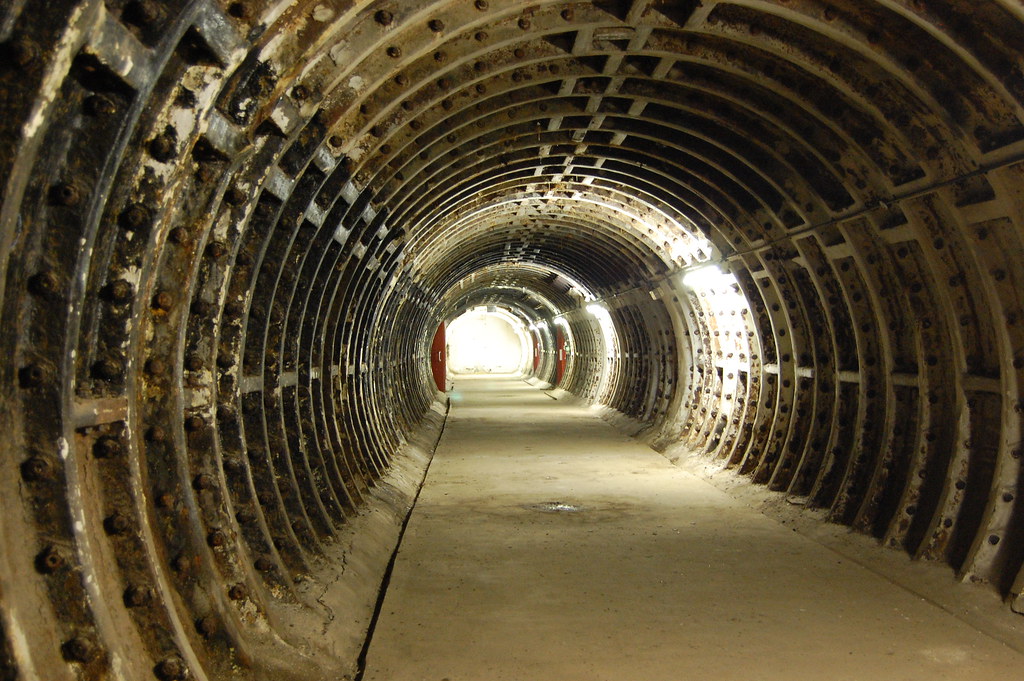When the Second World broke out in Europe, and London became the prime bombing target, people began to pour into the platforms of the London Underground —the city’s subway system— every night to escape the nightly bombings of the 1940 London Blitz. As these underground sanctuaries became increasingly crowded, the British government decided to construct proper air raid shelters far below the ground. The idea was to build ten shelters and place them slightly below and near existing subway stations with the intention that these newly built tunnels will be eventually absorbed into the Underground once the war was over.
The Stockwell deep level shelter entrance in London, now decorated as a war memorial. Photo credit: David Iliff/Wikimedia
Work on the shelters began in November 1940. Each shelter consisted of a pair of parallel tunnels 16 feet 6 inches in diameter and 1,200 feet (370 m) long. Each tunnel was subdivided into two decks, fully equipped with bunks, medical posts, kitchens and sanitation. Above ground, each shelter's shafts were protected by specially constructed 'pill box' buildings to prevent any bombs that directly hit the location from going underground. Each pill box housed lift machinery and provided the cover for spiral staircases down to the shelter's tunnels.
Originally ten shelters were planned, but only eight got built —one each at Belsize Park, Camden Town, Goodge Street, Chancery Lane, Stockwell, Clapham North, Clapham Common, and Clapham South tube stations. The final capacity of each shelter was also reduced to 8,000 from the planned 10,000.
The shelters were ready by 1942, but when the time came to open them to the public, the government got surprisingly cold feet. The worst of the bombings were already over, they argued, and the cost of maintaining the shelters would be too high once opened. Despite mounting pressure from the public, the authorities decided that the shelters would not be opened until the bombing intensified.
The arrival of the flying bombs, the V1 and the V2, finally moved the government to open the shelters to the public. Five of the shelters were opened and the remaining three continued to be used for various government use such as holding troops. Access to the shelters was controlled by tickets, but the demand was not high. The highest recorded nightly population was 12,297 on July 24, 1944, about one third of total capacity. After the scare of the flying bombs were over, the shelters closed once again and people returned back to the tube stations.
The shelters were used for their original purpose for less than a year. After the war, some of the shelters became temporary accommodation for the army in transit or were used as storage facilities. The Clapham South shelter used to house post-war immigrants from the West Indies. In 1951, it became the Festival Hotel providing cheap stay for visitors to the Festival of Britain. The Clapham North shelter is now a hydroponic farm and the rest are owned by Transport for London, and are still used for archival storage. The Clapham South shelter is now open for pre-booked tours arranged by the London Transport Museum.
Entrance to the Clapham South deep level shelter. Now rather nicely incorporated into a block of flats. Photo credit: Sheep"R"Us/Flickr
A busy night at Clapham South in July 1944, many of the original shelter signs are still in place today. Photo credit: Subterranea Britannica
Wherever possible families were kept together in the shelter often utilizing the cross bunks where two pairs faced each other. Shelter residents are seen hear making up their bunks on the upper floor. Photo credit: Subterranea Britannica
Photo credit: diamond geezer/Flickr
These stairs led to a tunnel connecting to Clapham South Tube station. It was built so that London Underground could connect the shelters and use them as part of an "express Northern Line" after the war. This never happened. Photo credit: Sheep"R"Us/Flickr
Bunks in Clapham South deep level shelter. Photo credit: Sheep"R"Us/Flickr
Photo credit: Tom Page/Flickr
Control room of Clapham South deep level shelter. Photo credit: Sheep"R"Us/Flickr
Clapham Common deep level shelter now houses an underground farm. Photo credit: Matt Brown/Flickr
One of the two entrances to the Goodge Street deep level shelter under Goodge Street station. Photo credit: secretlonddon123/Flickr
Entrance to Belsize Park deep level shelter. Photo credit: Sheep"R"Us/Flickr
Entrance to the Clapham Common deep level shelter. Photo credit: diamond geezer/Flickr
Sources: Wikipedia / Underground History / Subterranea Britannica




























Impressive engineering
ReplyDeleteJust need to mention a quick correction. "Shelter residents are seen hear making up their bunks on the upper floor." 'hear' should be 'here'.
ReplyDeleteThis was an interesting article. Thanks.